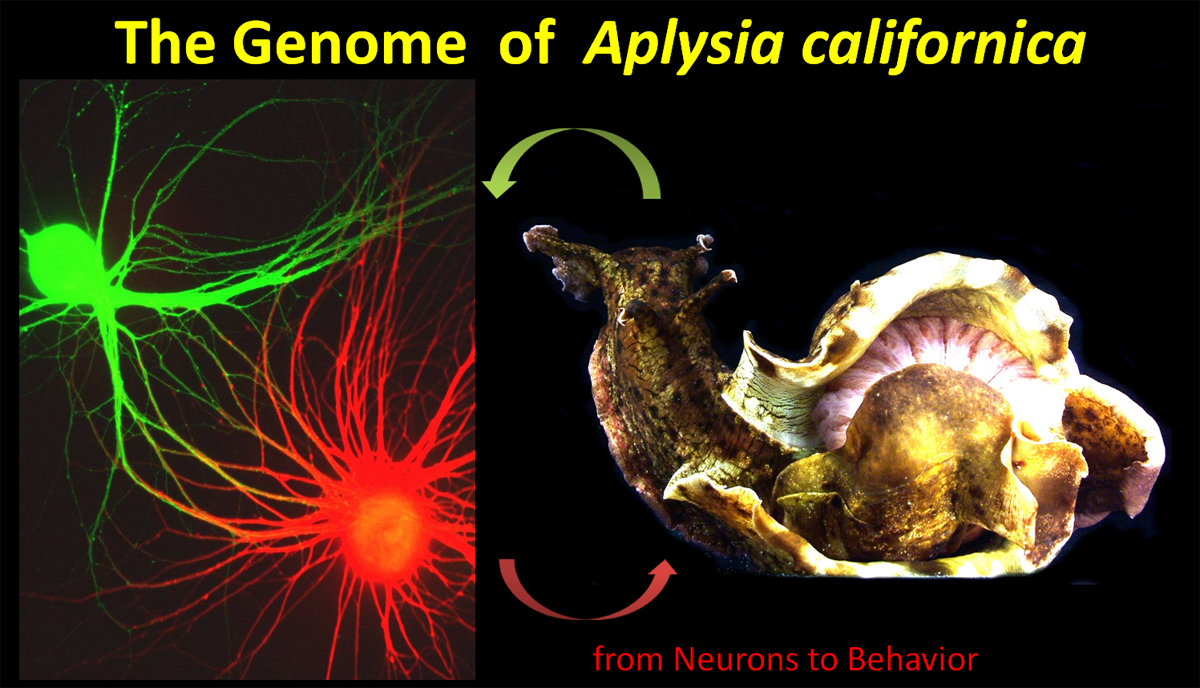
The Aplysia genome sequencing project was initiated in 2004 (see link to the white paper, http://www.genome.gov/pages/research/sequencing/seqproposals/aplysiaseq.pdf) and its first phase (initial Sanger sequencing at the Broad Institute) was supported by NIH. However, due to an unexpected complexity of repetitive regions and associated technical issues additional approaches are currently under way to improve the Aplysia genome assembly and annotation.
The 2nd phase of the project, spanning 2010-2012, focused on utilizing next generation sequencing platforms (Illumina, 454/Roche and Pacific Biosciences) to improve the coverage of the Aplysia genome and generate a hybrid assembly.
This web page is a work in progress that reflects ongoing efforts to complete the Aplysia genome assembly, its annotation, and analysis. The public release of the genome is a response to the needs of the larger research community, including the need to access raw data and initial version of the hybrid assembly. As a result, the genome assembly may be modified on a daily basis and will be subject to editing without any further notice, at the discretion of the authors. For the use of the information provided at this web please contact moroz@whitney.ufl.edu.
Participants of the current assembly and annotation projects: University of Florida (Prof. L.L. Moroz laboratory); the Broad Institute at MIT/Harvard (Drs. F. Di Palma and K. Lindblad-Toh groups); Columbia University (Prof. J. Ju and Prof. E.R. Kandel Laboratories).
About Aplysia (see also A Quick Guide in Current Biology)
The marine opisthobranch mollusk, Aplysia californica, is a powerful experimental system in cellular, molecular, and behavioral neuroscience as well as cell and evolutionary biology because of the distinctive organization of its nervous system, which makes it advantageous for cellular and comparative analysis of a variety of behaviors and learning and memory. Aplysia's large neurons allow examination of neuronal architecture of instinctive and learned behaviors at the level of single characterized cells and defined cellular compartments (e.g., synapses). As a result, many fundamental problems in neurobiology can be analyzed more effectively in Aplysias than in Drosophila, C. elegans, and vertebrates. In a larger sense work on Aplysia is synergistic with these other experimental systems. Here, we are sequencing the genome of Aplysia both to gain access to genomic mechanisms of basic neuronal and other functions and to study these mechanisms in real physiological time with single-neuron resolution.
The distinction of Aplysia as a neurobiological and cellular model system is due to the following: (1) Its nervous system has a relatively small number of nerve cells. (2) Many of these cells are large (sometimes gigantic, up to 1 mm in diameter). (3) As a result of their size, pigmentation, and position in the nervous system, many cells can easily be uniquely identified at the single cell level and can be reliably linked to the animal's behavior. (4) The cells provide enough messenger RNA to generate cDNA libraries from single cells. (5) These neurons can be isolated and cultured in vitro and they form circuits which can be explored in detail at molecular and cellular levels. (6) The animal generates a variety of behaviors, many of which can be specified in terms of their underlying circuitry. (7) Some of these behaviors can be modified by different forms of learning.
Aplysia are easy to rear in the laboratory from fertilized ova to mature adults and it is possible to obtain an inbred stock of reproducing animals. In 1995, the NIH established a National Resource Center for Aplysia at the University of Miami to meet the growing needs of the biomedical community. This Center supplies over 20,000 cultured Aplysia at all developmental stages annually to the research community throughout the world. This community consists of more than 100 laboratories and over a thousand investigators with overall research budgets of tens of millions of dollars annually. In addition to its value to the neurobiological community, Aplysia is also of interest from a comparative biological perspective. Aplysia is a free-living representative of Mollusca, the second largest animal phylum (after Arthropoda). Members of this phylum have received relatively little genetic study, even though they are of considerable significance for evolutionary and developmental biology and for basic and applied biomedical studies. Aplysia has a stable diploid genome consisting of 17 haploid chromosomes with highly polyploid central neurons. The genome size of about 850 million base pairs is typical for many molluscan species.
Expressed sequence tags (ESTs) have already been sequenced, including more than 50,000 unique sequences representing several thousand genes, from the central nervous system of Aplysia – see Moroz et al (2006) . These ESTs have revealed many signaling molecules and pathways, including their key receptors, kinases and substrate proteins, but many rare yet key genes (e.g., ionic channels) have escaped detection so far. To achieve a complete understanding of the biologically important genes and their regulatory elements, a careful annotation and analysis of the sequenced genome is analysis is required.
The Aplysia genome project will serve two major functions. First, it will be important for neuroscience by providing a critical resource for facilitating: (a) identification of all genes and regulatory regions of this valuable organism, (b) assembling microarrays and cDNA libraries for global expression studies, including those based on single neurons and their processes, and (c) gene function analysis by RNA interference screens. Second, the Aplysia genome will be important for comparative, developmental and evolutionary biology. Aplysia will serve as a complementary invertebrate/molluscan genomic model from the most diverse and second largest clade of bilaterally symmetrical animals. The Aplysia genome will promote studies of metazoan evolution, developmental biology, neuroscience, and human health, including identifying and validating therapeutic targets for human disorders that are related to aging, cancer, the central nervous system, as well as learning and memory mechanisms.




